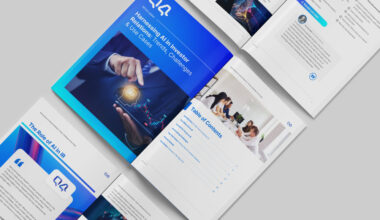In times of relatively low volatility, capital markets insights and surveillance capabilities are an important component of running a successful, well-informed, and communicative investor relations program. But in times of crisis, insights into stock and shareholder activities is literally critical.
We caught up with Billy Eckert, head of surveillance and capital markets at Q4, to discuss how these tools are adding value as we navigate through the COVID-19 pandemic. He shared how Q4 clients are leveraging access to market insights and pointed to surveillance best practices to consider in these unprecedented times. Billy reports that he’s never seen a higher level of engagement with surveillance, both with existing users and those interested in immediately tapping into this capability.
Increased value in times of crisis
Even during times of less volatility, surveillance strategies provide valuable visibility. And, where management and board compensation is tied directly to stock performance, it becomes even more important for leadership to understand stock drivers. For IROs, these market insights can help gauge whether their efforts are translating into developments in shareholder activity, inform future strategy, and highlight the value of the function.
Surveillance reveals changes and patterns within a shareholder base previously inaccessible. Weaving together robust and diverse intelligence sources can provide IR teams with a more complete view of their stock, including present and potential future investor sentiment.
“Surveillance helps uncover what’s behind market reaction and without it, it’s difficult to get an accurate read on what’s driving stock movement – sometimes for months,” explains Billy.
In times of chaos and volatility, waiting for this kind of clarity becomes an impossibility. The current COVID-19 global pandemic has triggered an insatiable need for immediate and ongoing intelligence.
“Beyond communicating how the stock is holding up, IROs are using the surveillance data to create a snapshot for the C-suite that is being communicated almost daily at this point,” Billy shares. Valuable on many levels, this intelligence can even help identify potential activist hedge funds getting into the stock that could really cause some damage. Armed with this information, teams can take proactive steps to get in front of these issues and mitigate damage.”
Billy reveals that the surveillance team has seen a new level of engagement from clients since the start of this health crisis as IROs feel pressure to provide any clarity available in this new environment. And, while surveillance data are often considered too “IR-centric” for broad distribution, in this time of crisis, this commentary is making its way into the board room every day.
Tapping into key indicators
While many key indicators have to be considered on a case or industry-specific basis in light of the current environment, there are some that provide clarity across industries. A key indicator for understanding shareholder movement is custodial bank (or DTC) data. This tells an IRO or C-Suite executive which types of banks are active, if there are any concerning accumulations that could point towards potential activist buying, and whether the movement in stock price observed over a period was attributable to larger movements by major shareholders, part of basket trades where the stock was moving on ETF, or fast money trades across the sector or broader market. This data can indicate whether the stock is moving with its peers or the broader market or, if there is something more Company-specific driving trading. Billy’s team considers DTC a critical element but, on a daily basis, also looks at how the stock performs – especially compared to the broader market.
“If there’s a big down day for the market, as we saw in mid-March, and a client’s stock is flat or higher, that’s a red flag that there could be an activist accumulating or, conversely, that there’s a large shareholder that took the opportunity to jump in when the stock price was low.” Billy explains. “Big, converse moves in a specific stock, versus a sector or market, is an important warning sign and something we put in front of our clients in real time.”
An important tool for Billy’s team is the Relative Performance Indicator, which allows the team to understand what is driving a stock’s absolute movement. If a stock is down 5%, for example, this tool can indicate what portion of that downside is stock-specific rather than driven by peer, industry or broader macro forces. He stresses that, at the end of the day, what’s most important is access to a specialist experienced at monitoring a holistic story and looking for variances versus a market or sector.
Best practices for leveraging insights through a crisis
Billy’s best advice is to increase the level of engagement with surveillance analysts. While an ongoing, two-way exchange is always the best case, engagement is essential now as it brings additional clarity, even uncovering whether a company is facing the same head winds as the rest of its sector or if there’s a specific obstacle on their horizon. Increased engagement sets the stage for surveillance experts to deliver insights in near real-time while assessing client updates to see if they sync with their own marketplace observations.
Billy’s team reports a number of best practices as it relates to leveraging surveillance reports to inform the C-suite and craft shareholder communications. With minimal time and resources available, many teams are simply pushing surveillance reports to management to deliver a picture of what’s happening in the market and with their shareholders specifically. Even this minimal level of reporting can be extremely valuable in informing strategic planning, but some IROs are taking a more proactive approach.
“We’ve seen some great examples of IROs taking data to the next level, digging into the data and using it to guide the next set of actions, whether that’s honing messaging, changing course, or targeting specific investors in the pipeline. These proactive IROs are hitting it out of the park by looking for ways to improve the value delta we’re seeing in the market.”
Most importantly, Billy is advising clients that the current volatility is here to stay, “While there are many past examples of shocks to the market, there’s frankly no comparable to what we’ll face as a result of this crisis. The lack of historical precedent is exactly why it’s so important to provide our clients as much data as possible, staying on top of the markets during and even outside of market hours.”
Especially in times of crisis, as management faces increased scrutiny and intensifies its focus on business fundamentals, companies don’t often have time to focus on what’s happening in the capital markets with any regularity. But because access to this surveillance becomes increasingly valuable in this environment, IROs should consider outsourcing to a customer-centric partner that can deliver the solution they need and be easily integrated into their IR program.
If you haven’t already, reach out to Q4’s team of technologists, analysts and former Wall St. traders to see how they can customize the service to provide the clarity your team needs – both during this global health crisis and beyond. Learn more about the value of Surveillance by reading Activating intelligence for the IRO of today and tomorrow.


